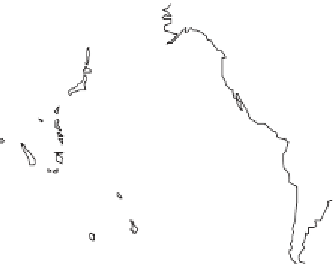Geoscience Reference
In-Depth Information
material, 4.5 per cent;
lahars
(mud flows), 3 per cent;
atmospheric shock waves, 3 per cent; and lava
avalanching into the sea, 1 per cent. About 25 per cent
had no discernible origin, but probably were produced
by submerged volcanic eruptions. The eruptions of
Krakatau in 1883 and Santorini in 1470 BC were
responsible for the largest and most significant
volcano-induced tsunami.
There has been no historical occurrence of tsunami
produced by a meteorite impact with the ocean.
However, this does not mean that they are an inconse-
quential threat. Stony meteorites as small as 300 m in
diameter can generate tsunami over 2 m in height that
can devastate coastlines within a 1000 km radius of the
impact site. The probability of such an event occurring
in the next fifty years is just under 1 per cent. One
of the largest impact-induced tsunami occurred at
Chicxulub, Mexico, sixty-five million years ago at the
Cretaceous-
Tertiary
boundary. While the impact was
responsible for the extinction of the dinosaurs, the
resulting tsunami swept hundreds of kilometers inland
around the shore of the early Gulf of Mexico. Impact
events are ongoing. Astronomers have compiled
evidence that a large comet encroached upon the inner
solar system and broke up within the last fourteen
thousand years. The Earth has repetitively intersected
debris and fragments from this comet. However, these
encounters have been clustered in time. Earlier civil-
izations in the Middle East were possibly destroyed by
one such impact around 2350 BC. The last rendezvous
occurred as recently as 1500 AD; however, it happened
in the southern hemisphere where historical records
did not exist at the time. Only in the last decade has
evidence become available to show that the Australian
coastline preserves the signature of mega-tsunami
from this latest impact event.
A partial geographical distribution of tsunami is
provided in Table 10.2, while the location of tsunami in
the Pacific since 47
BC
are plotted in Figure 10.11.
The worst regions for tsunami occur along the stretch
of islands from Indonesia through to Japan and the
coast of the Russia. Most tsunami in this region origi-
nate locally. Of 104 damaging tsunami in the past
century, only nine have caused damage beyond their
source regions. In the Pacific, these originate between
Japan and the Kamchatka Peninsula inclusive, along
the Aleutian Islands and south Alaskan coast, and along
the coast of South America. For example, the Chilean
earthquake in 1960 affected most of the coastline
Percentage of tsunami in the world's oceans and seas.
Table 10.2
Location
Percent
Atlantic east coast
1.6
Mediterranean
10.1
Bay of Bengal
0.8
East Indies
20.3
Pacific Ocean
25.4
Japan-Russia
18.6
Pacific east coast
8.9
Caribbean
13.8
Atlantic west coast
0.4
A
60˚
40˚
20˚
0˚
-20˚
-40˚
-60˚
90˚
150˚
-150˚
-90˚
Longitude
B
60˚
40˚
20˚
0˚
-20˚
-40˚
-60˚
90˚
150˚
-150˚
-90˚
Longitude
A) Spatial distribution of tsunami since 47
BC
;
B) source areas for Pacific-wide events (adapted from
National Geophysical Data Center and World Data
Center A for Solid Earth Geophysics, 1984).
Fig. 10.11
of the Pacific Ocean. Here, earthquakes greater in
magnitude than 8.2 affect the entire Pacific Ocean
and have a probability of occurrence of once every
















































































































































































































































































